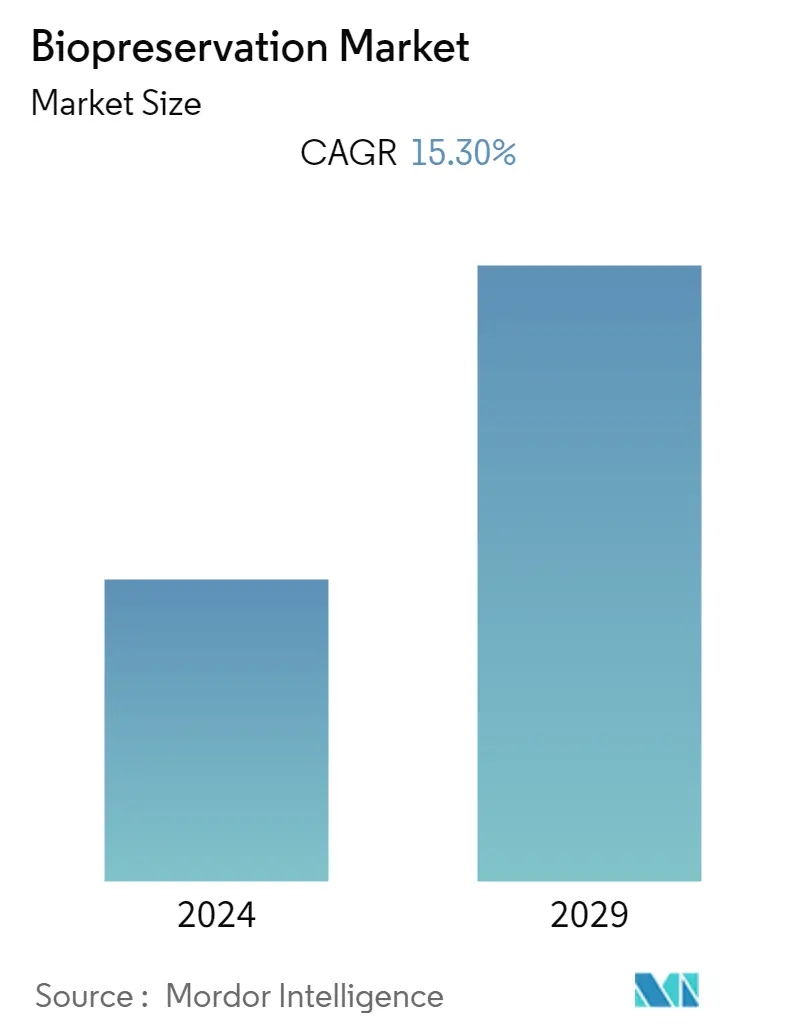Market Size of Biopreservation Industry

| Study Period | 2019 - 2029 |
| Base Year For Estimation | 2023 |
| CAGR | 15.30 % |
| Fastest Growing Market | Asia-Pacific |
| Largest Market | North America |
| Market Concentration | Medium |
Major Players
*Disclaimer: Major Players sorted in no particular order |
Biopreservation Market Analysis
The biopreservation market is expected to register a CAGR of 15.3% during the forecast period.
The impact of COVID-19 was significant owing to the increased research and development activities of pharmaceutical and biotech companies to prepare and manufacture a vaccine, which required biopreservation. For instance, an article published in Stem Cells Translational Medicine Journal stated that the pandemic resulted in the USFDA approving EUA for three mRNA vaccines that Pfizer-BioNTech manufactured in December 2020, Moderna in December 2020, and Janssen in February 2021. The shipping and storage requirements for these vaccines (ultra-cold vs. refrigerated) necessitated bioprocessing methods. Thus, the COVID-19 pandemic is expected to impact the market significantly.
Biopreservation has broad public health and socio-economic impacts, and it is affecting many lives across the world. It has been widely used to preserve cells and tissues, targeting its reproductive medicine and organ transplantation applications. Stem cell banking and gene banking have also gained global popularity.
Factors driving the market growth include improving healthcare expenditure, adopting in-house sample storage in hospitals and labs, and increasing research and development investment.
Biopreservation is crucial in evolving regenerative medicine. The rise in funding by companies to support biopreservation-based pharmaceutical companies to fulfill the growing demand for tissue and cell preservation is likely to propel market growth. For instance, in December 2021, X-Therma Inc., a biotechnology startup creating technology for regenerative medicine and organ preservation, closed an oversubscribed USD 13 million Series A funding round. The financing was being handled by the entrepreneur-run investment company LOREA AG, with participation from notable return angel investors as well as Zen11 Holdings, Graphene Ventures, VU Venture Partners, Methuselah Foundation, and a few others.
Also, in January 2022, Ori Biotech launched a cell and gene therapy platform after securing over USD 100 million in Series B funding. The interest of entrepreneurs and pharmaceutical companies in investing in a biopreservation company is likely to propel market growth.
Additionally, advancements in technology, increasing product approvals, partnerships, and acquisitions by key players, are helping in the market growth. For instance, in February 2022, Guy's and St Thomas', United Kingdom, launched a fertility preservation service for ovarian tissue cryopreservation for women undergoing cancer treatment. Growing technological advancements and launches in biopreservation, along with the cost-effectiveness of these instruments, are expected to create lucrative opportunities for the target market growth in the given timeframe.
However, the high cost of the instruments and their maintenance and the possibility of tissue injury during preservation is likely to impede the market growth.
Biopreservation Industry Segmentation
As per the scope of the report, biopreservation is a process that helps store biological samples for a longer period. Cells, tissues, and plasmas are some of the common biological samples preserved through biopreservation. The biopreservation market is segmented by Product, Biopreservation Media, and Equipment (Temperature Maintaining Units, Consumables, and Other Equipment), Application Area (Biobanking, Regenerative Medicine, Drug Discovery, and Other Application Areas), End User (Biobanks, Hospitals, and Other End Users), and Geography (North America, Europe, Asia-Pacific, Middle East and Africa, and South America). The market report also covers the estimated market sizes and trends for 17 different countries across major regions globally. The report offers the value (in USD million) for the above segments.
| By Products | |||||
| Biopreservation Media | |||||
|
| By Application Area | |
| Biobanking | |
| Regenerative Medicine | |
| Drug Discovery | |
| Other Application Areas |
| By End User | |
| Biobanks | |
| Hospitals | |
| Other End Users |
| Geography | ||||||||
| ||||||||
| ||||||||
| ||||||||
| ||||||||
|
Biopreservation Market Size Summary
The biopreservation market is poised for significant growth, driven by its critical role in healthcare and biotechnology sectors. The COVID-19 pandemic underscored the importance of biopreservation in vaccine development and storage, highlighting its necessity in maintaining the integrity of biological materials under varying conditions. This has led to increased investments and research in the field, particularly in regenerative medicine, where biopreservation is essential for cell and tissue preservation. The market is further bolstered by advancements in technology, product approvals, and strategic partnerships, which are enhancing the capabilities and applications of biopreservation. Despite challenges such as high costs and potential tissue injury during preservation, the market continues to expand, supported by rising healthcare expenditures and the growing demand for innovative medical solutions.
Regionally, North America is a key player in the biopreservation market, driven by the demand for preserving biological specimens across research and medical institutions. Government investments in drug discovery and regenerative medicine research are expected to further propel market growth in this region. The competitive landscape is characterized by a mix of global and regional players, with companies like BioLife Solutions and Merck KGaA leading the charge. Recent acquisitions and the launch of new products, such as cryopreservation solutions and storage devices, are indicative of the market's dynamic nature. These developments, coupled with the increasing focus on regenerative medicine, are anticipated to sustain the market's upward trajectory in the coming years.
Biopreservation Market Size - Table of Contents
-
1. MARKET DYNAMICS
-
1.1 Market Overview
-
1.2 Market Drivers
-
1.2.1 Improving Healthcare Expenditure
-
1.2.2 Adoption of In-house Sample Storage in Hospitals and Labs
-
1.2.3 Increasing R&D Investment
-
-
1.3 Market Restraints
-
1.3.1 High Cost of the Instruments and its Maintenance
-
1.3.2 Possibility of Tissue Injury During Preservation
-
-
1.4 Industry Attractiveness - Porter's Five Forces Analysis
-
1.4.1 Threat of New Entrants
-
1.4.2 Bargaining Power of Buyers/Consumers
-
1.4.3 Bargaining Power of Suppliers
-
1.4.4 Threat of Substitute Products
-
1.4.5 Intensity of Competitive Rivalry
-
-
-
2. MARKET SEGMENTATION (Market Size by Value - USD million)
-
2.1 By Products
-
2.1.1 Biopreservation Media
-
2.1.2 Equipment
-
2.1.2.1 Temperature Maintaining Units
-
2.1.2.2 Consumables
-
2.1.2.3 Other Equipments
-
-
-
2.2 By Application Area
-
2.2.1 Biobanking
-
2.2.2 Regenerative Medicine
-
2.2.3 Drug Discovery
-
2.2.4 Other Application Areas
-
-
2.3 By End User
-
2.3.1 Biobanks
-
2.3.2 Hospitals
-
2.3.3 Other End Users
-
-
2.4 Geography
-
2.4.1 North America
-
2.4.1.1 United States
-
2.4.1.2 Canada
-
2.4.1.3 Mexico
-
-
2.4.2 Europe
-
2.4.2.1 Germany
-
2.4.2.2 United Kingdom
-
2.4.2.3 France
-
2.4.2.4 Italy
-
2.4.2.5 Spain
-
2.4.2.6 Rest of Europe
-
-
2.4.3 Asia-Pacific
-
2.4.3.1 China
-
2.4.3.2 Japan
-
2.4.3.3 India
-
2.4.3.4 Australia
-
2.4.3.5 South Korea
-
2.4.3.6 Rest of Asia-Pacific
-
-
2.4.4 Middle East and Africa
-
2.4.4.1 GCC
-
2.4.4.2 South Africa
-
2.4.4.3 Rest of Middle East and Africa
-
-
2.4.5 South America
-
2.4.5.1 Brazil
-
2.4.5.2 Argentina
-
2.4.5.3 Rest of South America
-
-
-
Biopreservation Market Size FAQs
What is the current Biopreservation Market size?
The Biopreservation Market is projected to register a CAGR of 15.30% during the forecast period (2024-2029)
Who are the key players in Biopreservation Market?
BioLife Solutions , Lifeline Scientific Inc., Merck KGaA, Princeton CryoTech Inc. and VWR International, LLC are the major companies operating in the Biopreservation Market.

